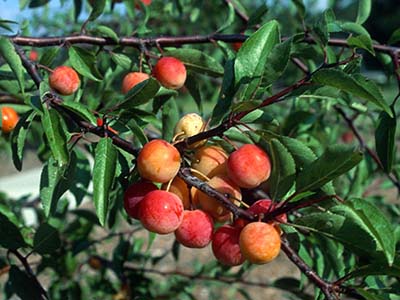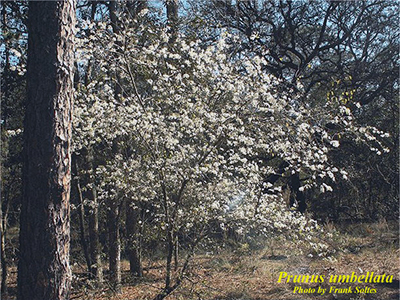Chickasaw Plum
Chickasaw plum is a native shrub or small tree that makes an attractive pollinator-friendly addition to any yard.

Chickasaw plum. John Ruter, University of Georgia, Bugwood.org
Characteristics
Each spring, Chickasaw plum trees are covered with clusters of tiny, fragrant, white flowers. The flowers bloom on the previous year’s wood and are especially dramatic since they appear before the trees puts out new leaves.
Then the small fruits appear, turning from red to yellow as they ripen. The tart plums can be eaten fresh or turned into tasty jelly, and they’re also enjoyed by wildlife.
Chickasaw plums form a rounded mass of slender, thorny branches around a short trunk. They can grow up to 25 feet tall, but are more often found in the 6- to 12-foot range.
Chickasaw plum is native to Florida and a number of other states and is hardy to USDA zones 5-9. It is known scientifically as Prunus angustifolia.
Planting and Care
The Chickasaw plum grows quickly, and can be used in the landscape as a small specimen tree. If you have trouble finding it at your local nursery, check a native plant nursery or sale.
Chickasaw plum will perform best in full sun, though it can also be planted in dappled shade. It will grow in a wide range of soil types but prefers an acid pH. If you don’t know your soil pH, your county Extension office can help.
When planting this or any shrub or tree, dig a hole that’s at least one and a half times as wide as the root ball but one inch shallower. Place the root ball in the hole and fill it in with soil, but don’t put any soil on top of the root ball.
Water the plant on a regular schedule until it’s established. After that it will be fairly drought tolerant, though it will perform best if it’s given some water during dry spells. It’s also resistant to most pests and diseases.
Chickasaw plum usually produces suckers around the base of the trunk. If you prefer a groomed appearance, you can prune these back to keep the tree in its best form. Another option is to allow the suckers to grow into a thicket around the plant that can serve as a home for birds, butterflies, and other wildlife.
Flatwoods Plum

A flatwoods plum tree in bloom.
Photo by Frank Soltes, courtesy of the Atlas of Florida Plants.
A similar tree is the flatwoods plum (Prunus umbellata), sometimes called hog plum. Like Chickasaw plum, this tree flowers in the early spring before leaves appear. Unlike the Chickasaw, it forms very few root suckers.
The flatwoods plum also produces edible fruits, small purple plums that range from very tart to very sweet. These trees do have thorns, so take care when picking the fruit and keep an eye on children who might be enjoying your landscape.
Flatwoods plum trees grow in North and Central Florida. When growing in a sandy soil these trees grow best with irrigation and some afternoon shade. Trees will grow quickly when they are young, as they mature and start bearing fruit their growth slows down considerably. At maturity these trees can grow to be 20 feet tall with a spreading canopy that is 15 feet wide. As an added bonus this plant is the host plant for the red spotted purple butterfly.
For more information on Chickasaw or flatwoods plum, contact your county Extension office.

